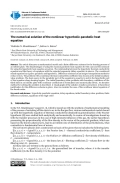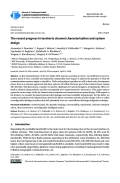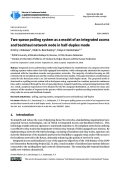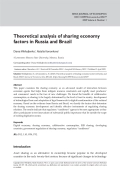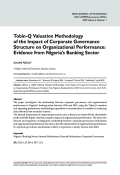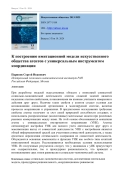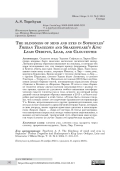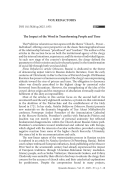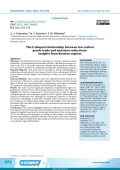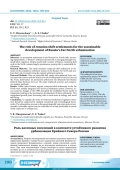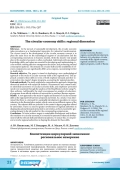The author examines the infl uence of physical culture on the formation of a professionals personality. The importance of personal physical education and mass sports in personality development.
The article discusses a mathematical model and a finite-difference scheme for the heating process of an infinite plate. The disadvantages of using the classical parabolic heat equation for this case and the rationale for using the hyperbolic heat equation are given. The relationship between the hyperbolic thermal conductivity equation and the theory of equations with the retarded argument (delay equation) is shown. The considered mixed equation has 2 parts: parabolic and hyperbolic. Difference schemes use an integro-interpolation method to reduce errors. The problem with a nonlinear thermal conductivity coefficient was chosen as the initial boundaryvalue problem. The heat source in the parabolic part of the equation is equal to 0, and in the hyperbolic part of the equation sharp heating begins. The initial boundary-value problem with boundary conditions of the third kind in an infinite plate with nonlinear coefficients is formulated and numerically solved. An iterative method for solving the problem is described. A visual graph of the solution results is presented. A theoretical justification for the difference scheme is given. Also we consider the case of the nonlinear mixed equation of the fourth order.
As the standardization of 5G New Radio (NR) systems operating in micro- and millimeter-wave frequency bands is over, scientific and industrial communities have begun to address the question of what 6G communications systems might or should be. While technological specifics are still in their early development phase, there is a common agreement that these systems will utilize the lower part of the terahertz band, namely, 100–300 GHz. This band poses a number of specific challenges for system designers, including the effects related to channel characteristics and the conceptually new requirements for electronics. This paper aims to report the current state-of-the-art channel characterization and communications system design. With respect to the former, we consider dynamic human body blockages and micromobility impairments. For the latter, we mainly concentrate on the physical layer devices for direct conversion schemes and the design of the so-called reconfigurable intelligent surfaces that will potentially serve as a cost-efficient blockage mitigation technique.
Integrated Access and Backhaul (IAB) technology facilitates the establishment of a compact network by utilizing repeater nodes rather than fully equipped base stations, which subsequently minimizes the expenses associated with the transition towards next-generation networks. The majority of studies focusing on IAB networks rely on simulation tools and the creation of discrete-time models. This paper introduces a mathematical model for the boundary node in an IAB network functioning in half-duplex mode. The proposed model is structured as a polling service system with a dual-queue setup, represented as a random process in continuous time, and is examined through the lens of queueing theory, integral transforms, and generating functions (GF). As a result, analytical expressions were obtained for the GF, marginal distribution, as well as the mean and variance of the number of requests in the queues, which correspond to packets pending transmission by the relay node via access and backhaul channels.
This paper examines the sharing economy as an advanced model of interaction between economic agents that helps them mitigate resource constraints and rapidly meet producers’ and consumers’ needs in the face of new challenges. We found the benefits of collaborative consumption, or sharing, to be largely determined by the level of trust in society, development of technological base and adaptation of legal framework to digital transformation of the national economy. Based on the evidence from Russia and Brazil, we classify the factors that determine the sharing economy development and identify effective instruments of regulating sharing relations. The results indicate that regulatory “sandboxes” appear to be most appropriate as they allow participants to test innovations of substantial public importance that lie outside the scope of existing legislative norms.
The paper investigates the relationship between corporate governance and organizational performance in Nigeria’s banking sector between 1996 and 2023, using the Tobin-Q valuation and operating performance methodology (quantitative characteristics) of variables in analyzing data collected from secondary sources.
The internal mechanisms of corporate governance such as Returns on Assets (ROA), shareholder profit and Debt-Equity ratio had a negative impact on organizational performance. The study into forecast and long-term co-integration relationship between corporate governance mechanisms and organizational performance has shown that the enhancement of organizational performance by corporate governance mechanisms is likely to experience a steady increase after 2023.
Developing the models of artificial societies with simulation of agents’ joint socio-economic activity a challenging task is to endow the agents with properties allowing them to mutually take into account each other’s intentions and activities. The presence of such properties in agents creates conditions for the emergence of social organization in the modeled system, including processes of coordination and governance. In the proposed study, agents obtain the required properties due to their natural ability to create and use shared (collective) mental models under various modes of communication between them. On this basis, the concept of an agent with a universal coordination instrument (UCI) is substantiated. Agents optimize UCI settings to take full account of each other’s activities and maximize the benefits of joint activities. UCI with settings is a common information environment for participants in joint activities, as well as a means of determining the optimal content of their joint activities. The main components and functions of UCI as a special type of agent-based simulation model are discussed. The necessary conditions for using the UCI are considered. From the results obtained it follows that individuals with UCI have both substantive and procedural rationality, which leads to the emergence of two types of equilibrium in the socio-economic system.
Сходство между Эдипом Софокла и Лиром Шекспира впервые было замечено несколько десятилетий назад. Литературоведы обратили внимание на эпизоды, в которых оба царя отталкивают тех, кто говорит правду (например, Тиресия и Кента), убиты два сына Эдипа и две дочери Лира, Эдип оплакивает свою жену и мать, мертвую Иокасту, а Лир — свою дочь, мертвую Корделию, Креон входит с трупом Антигоны, а Лир — с трупом Корделии, слепого Эдипа ведет Антигона, а слепого Глостера — Эдгар и т. д. Несколько лет назад (2019) был опубликован целый сборник статей, посвященных параллелям между «Эдипом в Колоне» и «Королем Лиром». И хотя в этом сборнике сходство между двумя пьесами анализируется с разных точек зрения, однако не уделяется особого внимания метафорическому смыслу слепоты ума и глаз, аспекту, на который автор данной статьи впервые обратил внимание в 2015 г. и более подробно рассматривает в этой статье. «Лучше быть слепым глазами, чем слепым умом»: это изречение армянского историографа V в. Егише, встречающееся и в других древних источниках, как нельзя лучше подходит к драматичной истории Эдипа, который, в свою очередь, имеет хорошо известные аналоги в шекспировском «Короле Лире» — Лира и Глостера. В статье рассматривается интересная параллель между этими тремя персонажами, а именно мучительный, трагический путь обретения ими мудрости через слепоту (в случае Эдипа это пророческая мудрость).
The Problema voluminis section opens with the theme “Church – Power – Individual”, offering a new perspective on the classic historiographical issue of the relationship between “priesthood” and “tsardom.” The authors of the articles in this section focus on both the institutional agency of the clergy and the internal intentions, experiences, and life stories of individual figures. At each new stage of the country’s development, the clergy defined the parameters of their mission and actively participated in the transformation of social life through both word and deed.
Relevance. The global imperative for adopting a low-carbon economy resonates worldwide, yet comprehensive assessments specific to the Russian economy remain scant. This is especially important considering the significant differences in the level of transition to sustainable development among Russian regions. Research Objective. This study aims to introduce a robust methodology for evaluating and analyzing the international trade of low-carbon goods (LCGs) across various Russian regions and assessing its effects on fuel combustion emissions. Data and Methods. Data on LCGs trade were obtained from the Federal Customs Service of Russia. In conjunction, datasets from Rosstat and the Central Bank of Russia were incorporated for comprehensive econometric modeling. The analytical framework employed Tobit and quantile regressions. Results. The study uncovers significant disparities among Russian regions regarding the intensity of low-carbon goods exports and imports. This variation highlights the diverse competencies in LCGs production, as well as differing ecological agendas and consumption patterns across regions. Additionally, the research demonstrates that, although the widespread adoption of advanced production technologies is positively correlated with increased fuel combustion emissions, a U-shaped relationship exists where higher LCGs exports are associated with reductions in fuel combustion emissions across Russian regions to a certain degree. Conclusions. This research highlights important implications for both federal and regional industrial and environmental policies. It advocates for the development of targeted incentives that encourage the adoption of low-carbon goods (LCGs) and advanced technologies. By doing so, policymakers can effectively promote sustainable development tailored to the unique needs and conditions of various regions, thereby fostering ecological resilience and economic growth across diverse regional landscapes.
Relevance. As permanent settlements in the Russian Far North suffer increasing depopulation, a “shadow” settlement framework is emerging through rotational labor migration. Despite nearly half a century of history, rotational shift work in the North remains largely spontaneous, posing risks to sustainable development. Research Objective. This study examines rotational shift settlements as elements of the population settlement system in the Russian Far North and analyzes their role in transforming the region’s settlement patterns. Data and Methods. Data on rotational shift camps were gathered from various open web sources and the Ministry for the Development of the Far East and the Arctic. Information on permanent settlements was obtained from Rosstat (Federal State Statistics Service). The study employed systemic and comparative analysis methods. Results. Unlike other Russian regions, rotational shift settlements in the Far North were initially integrated into the local settlement system. However, socio-economic changes in the 1990s disrupted the established Soviet model of integration, leading to the spontaneous development of these settlements. This unregulated growth poses increasing risks in such areas as ecology and social well-being. Conclusions. To regulate the status of rotational settlements, legislative initiatives should be supported by updated conceptual and terminological frameworks. The urbanization process in this geostrategically important and environmentally vulnerable region must be controlled or at least predictable to ensure timely responses to emergencies.
Relevance. In the pursuit of sustainable development, the circular economy takes precedence as a fundamental imperative for industrial transformation. The current trend in the development of the circular economy concept is to place the main focus on the technological support of circularization and the corresponding innovations in business models, while the decisive role people play in this model of economy is often overlooked. Individuals with specialized knowledge, skills, and values are essential for developing and implementing circular models, making effective management decisions, and promoting rational consumption patterns. The demand for circular skills and the availability of relevant competencies can significantly differ across regions, necessitating further in-depth study. Research objective. The paper is aimed at developing a new methodological approach to the study of circular economy skills at the regional level. This approach considers these skills in terms of both employer demand and their incorporation into master’s degree programs, accounting for regional specifics. Data and methods. The study employed a comprehensive approach, integrating theoretical methods with empirical analysis. Scientometric and content analysis identified taxonomies of circular economy skills, and employers’ personnel needs were examined through the analysis of the HeadHunter job site using Python software. Additionally, the study encompassed an analysis of educational programs from official websites of universities in southern Russian regions. Results. A new approach to the study of supply and demand of circular economy skills at the regional level has been proposed and tested. As a result, it was determined that there is a demand for sustainable development specialists in various industries in the Russian labor market, which varies across different regions of the country. The relevant skills are included in the master’s degree programs offered by universities. There is a need for greater involvement of regional authorities in shaping educational demands presented to universities, as this is essential for generating demand in the job market for the corresponding competencies. Conclusions. To better achieve targets in sustainable development and facilitate the transition to a circular economy, it is essential to promote a balanced development of all the relevant skills and behavioral patterns. To ensure this, it is important to involve regional authorities in shaping the demand for these skills.
